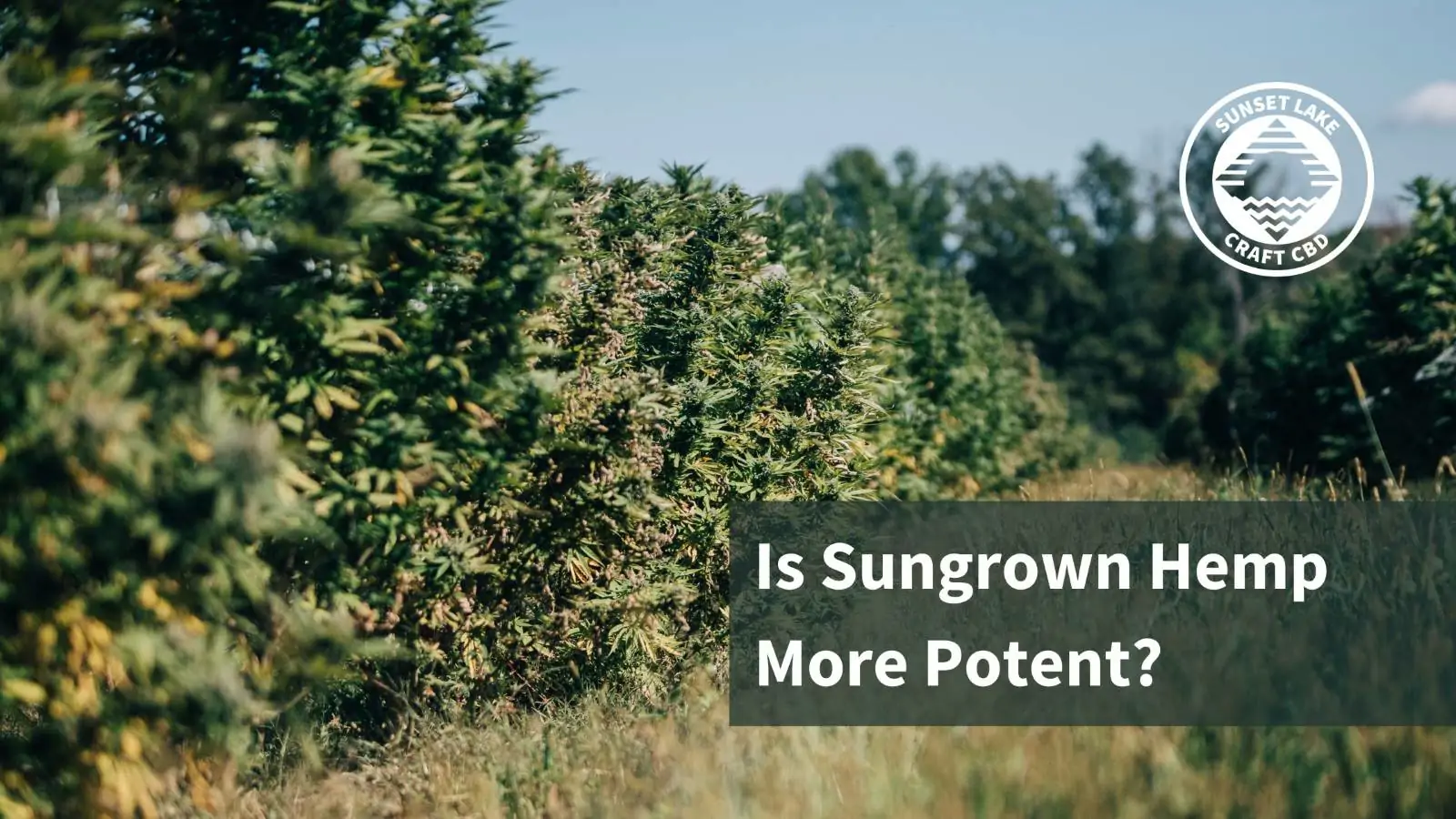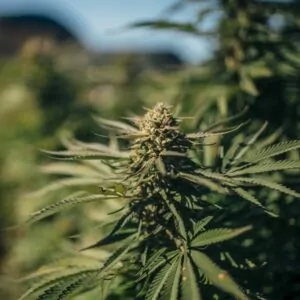No products in the cart.
CBD With A Conscience: Is Sungrown Hemp More Potent Than Indoor?

It’s truly remarkable how many different cannabinoids the hemp plant produces in its relatively short yet prolific lifespan. As of now, scientists have identified more than 100 cannabinoids and over 400 other plant-based (phyto-) chemicals that hemp produces. However, what remained unclear for a long time was how different environmental factors affected cannabinoid production—until recent studies shed light on this topic.
In this post, we’ll delve into a 2023 study that examines environmental factors such as light and soil and their impact on hemp flower potency. We’ll explore key questions such as:
- Is sungrown hemp more potent than indoor-grown hemp?
- Can the plant’s light source affect the user’s entourage effect?
- Do external factors influence terpene production?
What Is Sungrown Hemp?
Sungrown hemp is a specific type of outdoor hemp that germinates, reaches maturity, and fully flowers in natural sunlight. Unlike indoor hemp, which is grown under artificial lights, sungrown hemp is exposed to the beneficial bacteria in the soil and is more resilient to molds and pest pressures. This natural method of cultivation is believed to produce a more robust and potent plant.
Is Sungrown Hemp More Potent Than Indoor?
A study published in January 2023, titled “Comparison of the Cannabinoid and Terpene Profiles in Commercial Cannabis from Natural and Artificial Cultivation,” explored how different environmental conditions like light, soil, and available nutrients affected flower potency and terpene production. The researchers’ findings were quite surprising and challenged some common assumptions about hemp cultivation.
The Groundbreaking Study
Researchers began by acquiring genetically similar cannabis samples of the same cultivars from commercial growers. With the help of professional growers, they brought all the plants to maturity—some indoors under artificial lights and others outdoors under the sun.
The indoor plants were grown in a proprietary growth medium, while the sungrown plants were cultivated in a mixture of soil and compost under full sunlight. This setup allowed researchers to directly compare the effects of natural versus artificial growing conditions on hemp potency and terpene production.
To ensure the accuracy of their results, researchers prepared triplicates of trimmed, cured flowers and extracts from ground buds from each type of plant. The redundancy of samples helped to minimize any testing variance, providing a robust dataset for analysis.

Sungrown Hemp vs. Indoor Cannabinoid Production
The first area of focus was flower potency, which can also be thought of as cannabinoid concentration, or the weight of the flower that consists of cannabinoids. Given that hemp products are often marketed for their potency, understanding how the growing method influences this characteristic is crucial.
The study revealed that sungrown hemp expresses more unusual cannabinoids compared to indoor hemp. While there is still much to learn about how these unusual cannabinoids affect human physiology, their presence is known to enhance the entourage effect—a synergistic interaction between cannabinoids and other compounds in the plant.
Contrary to the common belief that indoor hemp is the most potent form of hemp, the study found that indoor hemp contains significantly greater amounts of oxidized and degraded cannabinoids compared to sungrown hemp. This finding suggests that sungrown hemp may offer a more desirable cannabinoid profile for consumers seeking maximum therapeutic benefits.
What Does Oxidized & Degraded Mean?
Degraded and oxidized cannabinoids can act differently when consumed. For instance, when THC (tetrahydrocannabinol) oxidizes and degrades, it converts into CBN (cannabinol), which is believed to have a more sedating effect than THC. This transformation can alter the overall experience and therapeutic potential of the hemp product.
Sungrown Hemp vs. Indoor Terpene Production
While cannabinoids are a critical component of hemp’s therapeutic profile, terpenes should not be overlooked. Terpenes are the aromatic compounds that give hemp and cannabis their distinct scents and contribute significantly to their therapeutic properties.
The researchers analyzed samples from both sungrown and indoor cannabis to study the effects of direct sunlight and soil on terpene production. Their findings supported what many sungrown farmers have asserted for years: sungrown hemp produces more terpenes and boasts a more varied, robust terpene profile.
Specifically, the study found that sungrown hemp contained higher levels of sesquiterpenes (C15H24), which are defined by their three isoprene units. These compounds are known for their anti-inflammatory, broncho-dilating, and antioxidant properties, making them highly valuable for both medicinal and recreational users.
More Unique Terpenes
Just like cannabinoids, terpene production plays a crucial role in determining hemp flower’s potential therapeutic value. Because terpenes contribute to anti-inflammatory, broncho-dilating, and antioxidant effects, their presence enhances the overall efficacy of hemp products.
Who Conducted This Study?
This study was conducted by several independent chemists from Columbia University without external funding from any cannabis companies. It was published in the Molecules Journal in early 2023, with the authors declaring no conflict of interest. This level of independence and transparency adds credibility to the study’s findings.
Why (We Believe) Sungrown Has the Advantage
At Sunset Lake CBD, we believe that indoor, outdoor, and sungrown hemp all have their place in the growing marketplace. However, from our perspective, sungrown hemp offers distinct advantages that make it superior in many ways.
Firstly, sungrown hemp is more energy-efficient. Growing plants under natural sunlight requires significantly less energy compared to maintaining artificial lighting and climate control systems in indoor growing facilities. This makes sungrown hemp a more sustainable and environmentally friendly option.
Secondly, sungrown hemp is better at sequestering carbon compared to indoor hemp. Plants grown outdoors contribute to carbon sequestration, helping to mitigate the effects of climate change. This environmental benefit is an important consideration for consumers who are mindful of their ecological footprint.
Lastly, sungrown hemp is more affordable to produce. Lower production costs can translate to more affordable prices for consumers, making high-quality hemp products more accessible to a broader audience.
In addition to these practical benefits, the study’s findings suggest that sungrown hemp is not only more potent but also offers a more diverse and robust cannabinoid and terpene profile. These qualities enhance the overall therapeutic potential of sungrown hemp, making it a preferred choice for many consumers.
Conclusion
In summary, the 2023 study comparing sungrown and indoor hemp provides compelling evidence that sungrown hemp may be more potent and beneficial than indoor-grown hemp. With its higher levels of unusual cannabinoids and terpenes, sungrown hemp offers a more effective and environmentally friendly option for consumers seeking the full benefits of the hemp plant.
As the hemp industry continues to evolve, it’s crucial to consider the environmental impact and therapeutic potential of different cultivation methods. At Sunset Lake CBD, we are committed to promoting sustainable practices and providing our customers with the highest quality hemp products available. if you need more information visit Sunset Lake CBD.
FAQs
What is the main difference between sungrown and indoor hemp?
- Sungrown hemp is cultivated outdoors under natural sunlight, while indoor hemp is grown under artificial lights in a controlled environment.
Is sungrown hemp more potent than indoor hemp?
- Studies have shown that sungrown hemp expresses more unusual cannabinoids and has less oxidized and degraded cannabinoids compared to indoor hemp, potentially making it more potent.
How do environmental factors affect hemp potency?
- Environmental factors like light, soil, and available nutrients significantly influence cannabinoid and terpene production in hemp, affecting its potency and therapeutic properties.
Why are terpenes important in hemp?
- Terpenes give hemp its distinct scent and contribute to its therapeutic properties, including anti-inflammatory, broncho-dilating, and antioxidant effects.
What are the environmental benefits of growing sungrown hemp?
- Sungrown hemp is more energy-efficient, better at sequestering carbon, and more affordable to produce compared to indoor hemp.
